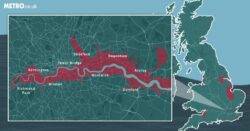Swathes of the UK, including large areas of London, could be underwater in less than three decades (Picture: Metro Graphics)
Rising sea levels are a concern for many countries around the world, as the effects of climate change sees sea ice melting at an alarming rate.
Coastal communities fear their homes and businesses being lost to the sea in the not-too-distant future – and that fear is increasing, as Office for National Statistics figures show 74% of over-16s in Britain are worried about the climate crisis.
These concerns have been unavoidable for Londoners, as throughout 2023 Just Stop Oil glued themselves to roads and painted sporting events orange to raise awareness of climate change – costing the Met millions.
But a new map which shows how the UK could look in 2050 has ramped up those concerns – especially in the capital.
Climate Central, who produced the data behind the map, predict huge swathes of the country could be underwater in less than three decades.
Areas shaded red on the map are those lower than predicted local sea water and coastal flood protections – as a two-mile wide band along London’s River Thames has been flagged as a danger zone.
England and parts of Wales are the parts of Britain likely to be worst affected (Picture: Metro Graphics)
It’s not looking good for London (Picture: Metro Graphics)
In a scenario in which ‘moderate’ reductions are made to the amount of human made pollution, and in which a ‘medium’ amount of luck keeps weather events on our side, great swathes of the country will be enveloped.
In the north of England, Liverpool, Southport, Blackpool and Morcambe are predicted to be swamped by rising sea water.
In the south-west the River Severn will play havoc, with stretches on either side of the estuary – from Taunton up to Tewkesbury and then back down to Cardiff on the northern bank – at risk of being lost to the waves.
Mercifully, Scotland and Northern Ireland look to be less seriously affected, with only small areas along rivers and in the Hebrides underwater.
The conclusion that should be drawn from viewing the map is clear: if we don’t stop releasing green house gases into the air, large parts of Britain will be underwater.
The data was put together in a report entitled ‘Flooded Future: Global vulnerability to sea level rise worse than previously understood’.
The Climate Central report explains: ‘As humanity pollutes the atmosphere with greenhouse gases, the planet warms. And as it does so, ice sheets and glaciers melt and warming sea water expands, increasing the volume of the world’s oceans.
More: Trending
‘The consequences range from near-term increases in coastal flooding that can damage infrastructure and crops to the permanent displacement of coastal communities.’
But there is still hope for London and the UK’s coastal communities. Following the COP28 summit in Dubai last year, the world pledged to ‘transition away’ from the use of fossil fuels, which is intended to reduce greenhouse gas emissions.
Sea levels are expected to rise between 2-7ft by the end of the century, so strong efforts to reduce the impact of the climate crisis could keep that rise to the lower end of the spectrum, reducing its impact.
Get in touch with our news team by emailing us at [email protected].
For more stories like this, check our news page.
Coastal communities fear their homes and businesses being lost to the sea in the not-too-distant future.





